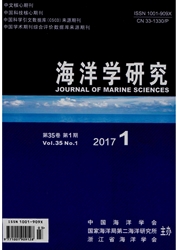

 中文摘要:
中文摘要:
对南海北部C4站柱状沉积剖面进行了高分辨率孢粉、藻类成分的分析和研究,同时测定了部分样品的AMS14C年代,划分了该站柱状沉积物地层时代,相应恢复了南海北部9800aBP以来植被、气候、环境的3个演替阶段。南海北部C4站从下至上可划分成3个孢粉组合带,依次为:1带(258~194cm):以Pinus—Quercus(常绿)-Polypodiaceae—Pterdium-Pteris—Dicranopteris—Adiantum为主孢粉带;2带(194~94cm):以Pinus-Quercus(常绿)-Pteridium—Polypodiaceae~Microlepia—Dicranop—teris为主孢粉带;3带(94~4cm):以Pinus—Pteridium—Polypodiaceae—Quercus(常绿)-Microlepia-Di—cranopteris为主孢粉带。与3个孢粉带相对应的古植被阶段依次为:伴有针叶树的常绿阔叶、落叶阔叶混交林,热带半常绿季雨林,热带常绿阔叶、落叶阔叶混交林,与周边地区的植被演替相一致。由此可见,研究区经历了全新世早期气候转暖,中期气候炎热、干湿季明显、海平面上升以及晚期气候暖热、湿润3个古环境演变阶段。
 英文摘要:
英文摘要:
Based on the high-resolution sporopollen and algae research of the sediments at Core C4 in the northern South China Sea, three sporopollen zones have been distinguished in ascending order.Zone 1 ( 258 - 19 4 cm) : Pinus-Quercus (evergreen)-Polypodiaceae-Pterdium- Pteris-Dicranopteris-Adiantum.Zone 2 ( 194 - 94 cm) : Pinus-Quercus (evergreen) -Pteridium-Polypodiaceae-Microlepia-Dicranopteris.Zone 3 (94 - 4 cm) : Pinus-PteridiumPolypodiaceae-Quercus (evergreen)-Microlepia-Dicranopteris. The sporopollen zones reflect three stages of vegetation, climate and paleoenviornment evolution of the northern South China Sea since 9800 years ago. Stage 1. Shown by palynological Zone 1 in Core C4 and Shelf Core 9, the vegetation on the continental margin and Hainan Island is evergreen and deciduous broadleaved mixed forest with conifers. The tree layer are dominated by evergreen Quercus, Castanopsis, deciduous Quercus, Pinus, Altingia, Myrica, Euphorbiaeeae and so on. Vegetation layer under canopy include Gramineae, Polypodiaceae, Pteridium, Cyathea and Dicranopteris. During this period, the evergreen broadleaved elements in the southern subtropical group southward migrated, and those deciduous broadleaved elements adapting to the warm and humid environment developed well. The climate at that time became warmer. The AMS14C age at the depth of 258-260 cm in Core C4 was 9800± 40 a B P. Stage 2: This stage is indicated by the palynologmal zone z in Core C4 and Core 9 from shelf in South China Sea. The elements from the southern subtropical and tropical zone increased in the vegetation on the continental margin and Hainan Island, where the trees were luxuriant. The main components were evergreen Quercus, Castanopsis, Altingia, Elaeocarpus, Euphorbiaceae, and others including Podocarlus, Dacrydium and Pinus. Mangrove plants grown along the coastal areas. Vegetation layer under canopy consisted of Gramineae, Cyperaceae, Ranunculaceae, Polypodiaceae, Pteridium, Cyathea and Pteris. The vegetation, chara
 同期刊论文项目
同期刊论文项目
 同项目期刊论文
同项目期刊论文
 期刊信息
期刊信息
